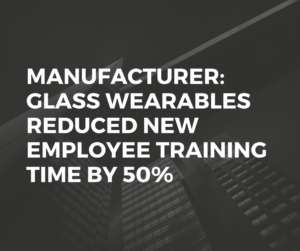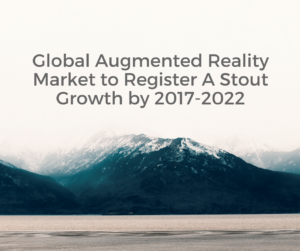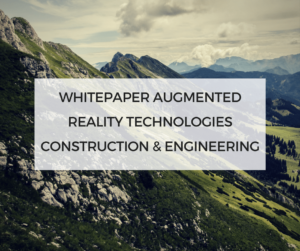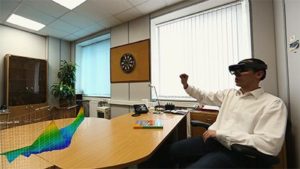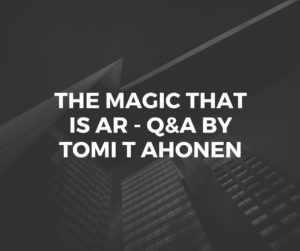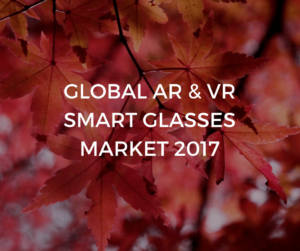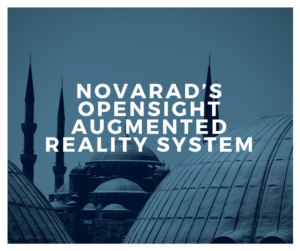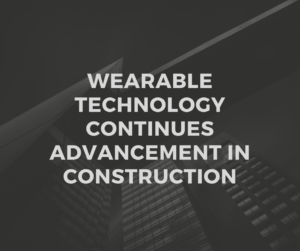AR/MR-assisted trading and data analysis platforms empower traders and investors with advanced fintech, which is capable of monitoring and visualizing financial markets with new depth. Holographic visualization presents a new enhanced view of dynamic data, with flat images evolving into 3D shapes and innovative heatmaps to reveal revolutionary new data insights. With an AR/MR-assisted user interface, users are no longer restricted by the physical size of a computer screen, mobile or tablet, and can get a true 360-degree view with unlimited applications.
Utilizing light portable MR headset technology or AR smart glasses, advanced holographic representations of financial data and feeds are overlaid on, and exist in addition to, the real-world view of the user’s workspace. The phrase “workplace everywhere” has new meaning with AR enabling users to simultaneously operate a laptop or smartphone, or speak with a physical person in the room at the same time as a virtual colleague via videoconferencing.
The AR financial landscape can remain completely private (safe from inquisitive eyes), or users can share data by mirroring their views to an external laptop and even enable “spectator view” for colleagues or clients who are also using AR/MR technology. Users can even invite clients or advisors located anywhere in the world to a virtual conference room, where they can collaboratively and seamlessly analyze and interact with their financial landscape.

The technologies behind the solution
Powerful AR/MR-assisted trading and market data analysis for the finance sector can be viewed through Microsoft’s MR HoloLens headsets, and new technology currently in development that will look and feel like ordinary eyeglasses. The inclusion of Unity, a powerful editor, enables the software to be transported to other wearable hardware. While the solution largely uses HoloLens gesture recognition technology, voice recognition is also possible using embedded Microsoft Cortana functionality, along with holographic object manipulation, which can be useful in certain scenarios.

The core of the AR/MR-assisted financial trading and market data analysis platform is built on an existing data solution called dxFeed, which is one of the world’s largest cloud-based fully-managed data tickerplants focused exclusively on the Capital Markets industry. dxFeed uses unique technology called QD, designed and built by Devexperts, for market data distribution. The result is a powerful tool that can transform and adapt any data feed into an AR/MR-assisted virtual market data infrastructure. Gathering and storing historical data from the key exchanges in the USA, Canada and Europe, every single change of price (tick-by-tick market data), is streamed live and can be accurately viewed and interrogated through the AR/MR headset.
What it means for traders and analysts
The advent of AR/MR-assisted trading and data analysis delivers many benefits to financial services firms:
- Organizations can replace multiple monitors in a fixed location with a lightweight wireless MR headset or AR smart glasses, freeing users from the physical size restrictions of computers, mobile devices, and tablets.
- Companies can implement “workplace everywhere” – with a 360-degree view, users can work literally on any surface and even in the air.
- Colleagues and customers can collaborate on projects from anywhere in the world via videoconferencing; point-of-view capabilities enable users to monitor and jointly analyze financial data, limiting miscommunication and strengthening decision-making.
- Users can increase their productivity and dramatically improve market visualization with advanced holographic data representation – a key element for traders needing to make important data-driven decisions quickly.
- A more intuitive user interface makes it easier to view, analyze and manipulate large quantities of complex data.
- Users can gain rapid access to stored historical market data and use tick-market replay and back-testing while simultaneously keeping a sharp eye on current market activity.
- Users stay better informed with streamlined integrated news feeds and financial information, aggregated from multiple providers in text view – with support for live streaming of news channels.
Who are the target users?
Fintech is more than a buzzword. In order to stay ahead of the competition, banks, investment-funds, hedge funds, FX desks, proprietary traders, and exchanges are adopting AR/MR technology. The driving force behind AR/MR-assisted trading and data analysis, however, is individual traders, investors and advisors working for financial institutions across the globe, who will find ease of collaboration from anywhere hugely beneficial.
Some typical scenarios
- An investor can connect an advisor to a virtual conference room, enabling them to share their point of view and explain how a drop or rise affects the portfolio and what decisions they can make now.
- A trader can take action faster as a result of a more intuitive interface highlighting hotspots and revealing opportunities.
- An investor looking to enter new markets can accurately view historical data, use tick-market replay and back-testing and make informed decisions based on the hard facts.
- A financial analyst required to monitor a particular stock on a major exchange can access and visualize full-depth data, explore how well the stock has performed in the past, and instantly communicate that information to a client, in the form of a holographic data representation.
- Students or new employees learning to trade can use AR/MR-assisted fintech to study and analyze patterns using historical data and market replay, and immerse and interact with the financial market.
Dmitry Parilov is Managing Director of Data Products at Devexperts and Simon Raven is a technical writer.
